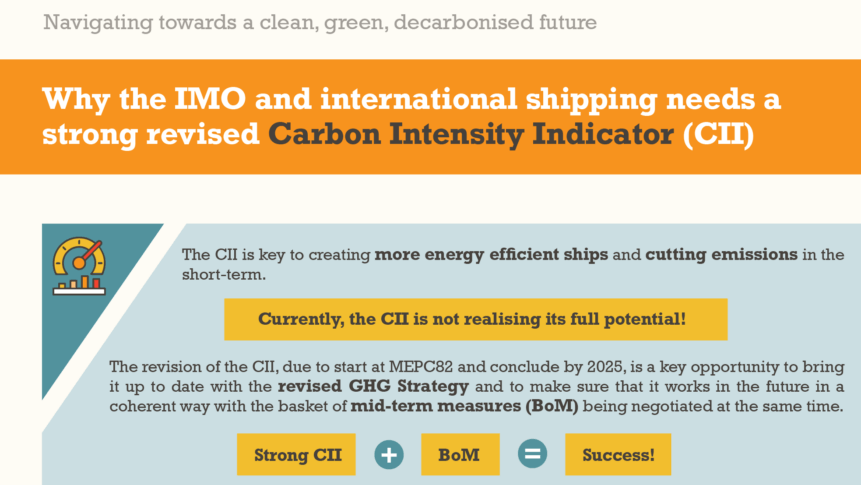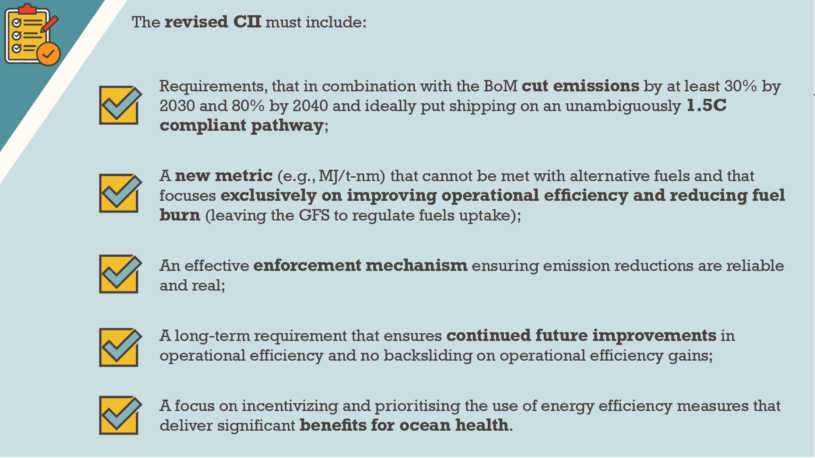New ships already meeting 2020 design efficiency standard

A new CE Delft study has revealed that many recently constructed ships already meet the International Maritime Organisation’s design efficiency standard for 2020, indicating that there is significant room for tightening these standards when the IMO meets next week.
The study, commissioned by Brussels based NGOs Seas at Risk and Transport & Environment, calculated the Estimated Index Values (EIVs) of new ships built between 2009 and 2014 and concluded that the majority of container and general cargo ships built in recent years already meet the IMO’s Energy Efficiency Design Index (EEDI) standards set for 2020 [1].
While there was a small improvement in the design efficiency of new ships between 2009 and 2012, this changed significantly in 2013 and 2014. The table below shows the percentage of ships built in 2013 and 2014 with EIV scores that meet or exceed the EEDI for 2020.
|
Containers |
General Cargo |
Bulkers |
Tankers |
Gas tankers |
Combination Carriers |
|
| 2013 |
51% |
66% |
3% |
5% |
6% |
11% |
| 2014 |
61% |
50% |
8% |
26% |
13% |
13% |
Of the ships in the study that were built in 2014 some 34% of containerships and 43% of general cargo ships also met the EEDI target for 2030.
The study also shows that the actual percentage of ships meeting the EEDI targets will be greater, as the EIV is in general an underestimate of the EEDI score [2].
The study identified a large variation in the EIV of ships of similar type and size, indicating that large additional fuel savings and associated reductions in CO2 emissions would be possible if all ships were built to the best available designs and technologies.
The EIV improvements have coincided with increases in average design speed and decreases in main engine power for a number of ship categories, suggesting that hull or propulsion efficiency has been improved. The findings also suggest that, if design speeds were kept constant, larger improvements in design efficiency would have been possible.
The IMO’s Marine Environment Protection Committee (MEPC) will hold its 68th session in London from 11-15 May, and will be reviewing the suitability of existing EEDI targets. The shipping industry claims that it is already doing enough on the environment and regulators should look elsewhere. However a recent study for Seas At Risk and Transport & Environment has already shown that recent ship designs are actually, on average, less efficient than those from 1990 [3][4]. This second study shows that much greater efficiencies can be delivered quickly if EEDI targets better reflect best available designs and technologies.
Bill Hemmings, Shipping Programme Manager with Transport and Environment, said: “Along with the earlier study of historical design efficiency trends, this latest work only confirms that the EEDI targets need substantial revision. The current standards fail to reflect best practice or the pace with which improvements in efficiency can be brought about.”
John Maggs, Senior Policy Advisor with Seas At Risk and President of the Clean Shipping Coalition, said: “Shipping is a significant and growing contributor to global greenhouse gas emissions. If the IMO’s Energy Efficiency Design Index is to be fit for purpose, new reduction targets must be agreed that take account of what “best in class” designs can already achieve.”
Notes to editors:
[1] As of January 1st 2013, all newly constructed ships have to meet design efficiency standards adopted by the IMO (Energy Efficiency Design Index –EEDI values). The design efficiency standards that new ships must meet are a function of ship type and size of ship. The standards are based on an empirical regression line of the efficiency of ships built between 1999 and 2009 which is called the reference line (RL). Below the EEDI design efficiency standards that need to be achieved:
| Year | 2013 | 2015 | 2020 | 2025 |
| Required | RL | RL -10% | RL -20% | RL -30% |
[2] While the EIV score used in the report is not the same as the EEDI score, CE Delft has compared known EEDI scores of recently built ships with their EIV scores and determined that there is a very significant correlation, allowing EIV to be used as a proxy for EEDI in assessing the effectiveness of the EEDI.
[3] New ships 10% less fuel efficient than those built in 1990: study, 13th April 2015 –
http://www.cleanshipping.org/new-ships-10-less-fuel-efficient-than-those-built-in-1990-study/
[4] Seas At Risk and Transport & Environment are both members of the Clean Shipping Coalition which has Consultative Status at the IMO and will be attending MEPC68.


